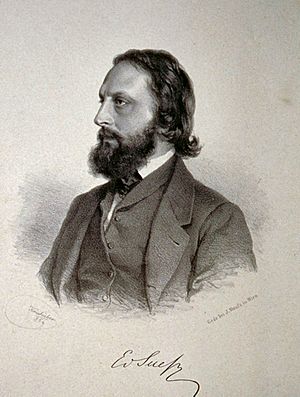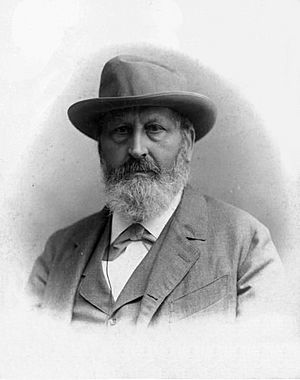Eduard Suess facts for kids
Quick facts for kids
Eduard Suess
|
|
|---|---|

Eduard Suess, 1869
|
|
| Born | 20 August 1831 London, England
|
| Died | 26 April 1914 (aged 82) Vienna, Austria
|
| Resting place | Marz, Austria |
| Nationality | Austrian |
| Alma mater | University of Vienna |
| Known for | Biosphere, Gondwana, Tethys Ocean, Das Antlitz der Erde, Eustatic Theory, Sima, sial |
| Spouse(s) | Hermine née Strauss |
| Children | 5 sons, 1 daughter |
| Awards | Hayden Memorial Geological Award (1892) Wollaston Medal (1896) Copley Medal (1903) |
| Scientific career | |
| Fields | Palaeogeography, tectonics |
| Doctoral students | Melchior Neumayr Johann August Georg Edmund Mojsisovics von Mojsvar Fuchs Wilhelm Heinrich Waagen Albrecht Penck |
| Influenced | Jovan Cvijić |
Eduard Suess (born August 20, 1831 – died April 26, 1914) was an Austrian geologist. Geologists study the Earth's rocks, land, and history. Suess was an expert on the geography of the Alps mountains. He is famous for suggesting two big ideas about Earth's past. He proposed the existence of a huge ancient landmass called Gondwana and a large ancient sea called the Tethys Ocean.
Contents
Who Was Eduard Suess?
Eduard Suess was born in London, England, on August 20, 1831. His father, Adolph Heinrich Suess, was a merchant. His mother was Eleonore Friederike Zdekauer.
When Eduard was born, his family moved to Prague. Later, when he was 14, they moved to Vienna, Austria. He became very interested in geology when he was young.
At age 19, he worked at the Hofmuseum in Vienna. There, he published his first scientific paper. It was about the geology of a place called Karlovy Vary (now in the Czech Republic).
In 1855, Suess married Hermine Strauss. They had five sons and one daughter together.
His Work at the University
In 1856, Suess became a professor at the University of Vienna. He taught about paleontology, which is the study of ancient life through fossils. In 1861, he became a professor of geology.
He started to develop ideas about how Africa and Europe were connected in the past. He thought that the Alps mountains were once at the bottom of an ocean. He believed the Mediterranean Sea was a small part left of that old ocean.
Suess's early ideas about how the Earth changed were based on "contractionism." This was a theory that the Earth was cooling down and shrinking. While this idea wasn't fully correct, he was right about the ancient ocean. He named this ocean the Tethys Ocean in 1893.
Discovering Ancient Continents
In 1885, Suess suggested that land bridges once connected South America, Africa, India, Australia, and Antarctica. He called this huge, ancient landmass Gondwanaland.
Between 1885 and 1901, Suess published a major work called Das Antlitz der Erde. This means The Face of the Earth. It was a very popular textbook for many years.
In this book, he explained his idea that sea levels changed all over the Earth at the same time. He believed that periods when oceans covered more land (transgression) and when they pulled back (regression) happened globally.
His theory was based on finding glossopteris fern fossils. These fossils were found in South America, Africa, and India. He explained this by saying these lands were once part of a single supercontinent, which he named Gondwanaland.
The Biosphere Idea
In another work, Die Entstehung der Alpen (The Origin of the Alps), Suess introduced the idea of the biosphere. The biosphere is the part of Earth where life exists. This includes land, water, and air.
He wrote that living things are found in a specific zone on Earth's surface. He used a plant as an example. A plant's roots go into the soil, and its leaves reach into the air. This shows how life connects the ground and the atmosphere.
Awards and Death
Eduard Suess received many honors for his work. He became a member of the American Philosophical Society in 1886. He also joined the Royal Swedish Academy of Sciences in 1895.
He won the Wollaston Medal in 1896 and the Copley Medal in 1903. These are very important awards in science.
Suess died in Vienna on April 26, 1914. He is buried in Marz, Austria.
His Legacy
Eduard Suess is seen as one of the first people to study ecology. Ecology is the study of how living things interact with each other and their environment.
Several places are named after him:
- Suess Land in Greenland.
- The lunar crater Suess on the Moon.
- The crater Suess on Mars.
Franz Eduard Suess
His son, Franz Eduard Suess (1867–1941), also became a geologist. He worked at the Imperial Geological Institute in Vienna. He studied moldavites, which are natural glass formed from meteorite impacts. He also created the word tektite for these types of rocks.
An asteroid, 12002 Suess, was named in honor of Franz Eduard Suess. It was discovered by Czech astronomers in 1996.
Major Works
- About the Brachiopods of the Kössen Layers (1854)
- The Soil of the City of Vienna (1862)
- The Origin of the Alps (1875)
- The Face of the Earth (1885–1909) - This was a multi-volume work.
- Memories (1916)
See also
In Spanish: Eduard Suess para niños


